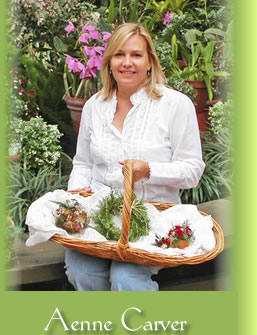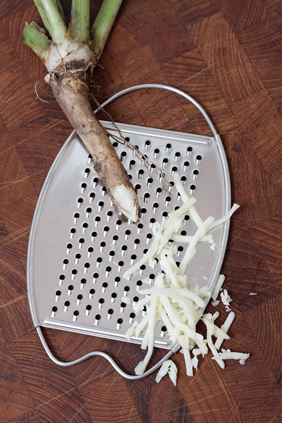 Gardens are a form of autobiography, art, and create joy. Live your
life more fully through gardening.
Email:aenneherb@aol.com
|
Horseradish
(Armoracia rusticate syn.
Cochlearia armoracia)

Creamed, pickled, or freshly grated, horseradish explodes in your mouth. Eating horseradish opens your sinuses and roars up the back of your throat. Nicknamed sting nose, this herb packs a historical and culinary punch.
Horseradish has been cultivated for more than 3,000 years. In fact, Medieval people regarded horseradish as an aphrodisiac and a cure all herb. Infusions of horseradish were used to treat toothaches, coughs, gout, rheumatism, and more. In the Bible, horseradish is one of the five bitter herbs and it continues to be served at Passover. Today, horseradish is used in massage therapy to alleviate muscle soreness, and to clear up chest congestion.
In the garden, expect this pungent perennial to have fleshy roots, long-lobed leaves, and clusters of white flowers. The roots are said to resemble a horse, but only if you have an excellent imagination. Though horseradish is publicized as a nondescript plant, the variegated variety (Armoracia rusticana ‘Variegata’) is surprisingly stunning.
To grow this herb, plant in the early spring, in rich, loose soil, and in full sun. Unfortunately, horseradish is almost impossible to grow from seed. Root cuttings (sometimes called sets) are available in nurseries in fall and early spring.
After digging to loosen the soil and amending it, dig a hole deep enough to hold the length of the root cutting. Then, hold the root upright and back fill until all but the tip or crown is covered. Horseradish spreads vigorously once established. To prevent an invasion, grow horseradish in a large container. Alternatively, plant horseradish in a bottomless, plastic pot placed into the garden soil. This keeps horseradish in check, yet allows for good water drainage.
As soon as new growth begins the following spring, harvest the roots. In mild climates, this works better than harvesting in the late fall as prescribed by most experts. Besides, harvesting in the spring avoids the hassle of overwintering root cuttings in moist sand somewhere out of the light.
Sometimes people confuse wasabi and horseradish because they generate similar heat and both come from roots. Wasabi comes from the rhizome of Wasabia japonica. However, both horseradish and wasabi are members of the large Cruciferae/Brassicaceae family, which also includes mustard, kale, broccoli, and cabbages.

Grated Horseradish
Despite potential tears, horseradish is worth incorporating into your diet because it is richer in vitamin C than oranges, and stimulates the digestion of fatty foods. Here are a couple of basic recipes to get you started.
Homemade Horseradish
Ingredients:
- 1 cup cubed peeled horseradish root, cut into ½ inch pieces
- ¾ cup vinegar
- ¼ cup of sugar
- 1 tsp. salt
Combine all ingredients in a food processor, except vinegar and grind well. Timing is important when adding the vinegar because the longer you wait the hotter horseradish. For less heat, add the vinegar one to two minutes after processing, for hot horseradish wait six to eight minutes. Add vinegar according to your preferred timing and puree. Cover and store the horseradish in the refrigerator. This recipe makes about 1½ cups.
Horseradish Mustard Mayonnaise
Ingredients:
- 1/4 cup whole grain mustard
- 1/4 cup good quality mayonnaise
- 1/8 cup prepared horseradish or homemade ( or try above recipe)
- salt & fresh ground black pepper
Combine all ingredients together and mix well. Season to taste with salt and pepper.
Horseradish Massage oil
Mix 1 tablespoon of freshly grated horseradish roots to 1 cup of any cold-pressed oil, such as olive,wheat germ,or sesame oil. Let mixture sit for a couple of hours, then sieve out the roots and use the oil on achy muscles or sore joints. |
 |

